Differences in description of flavor and taste of coffee bean varieties in three major coffee producing areas

Professional coffee knowledge exchange more coffee bean information please follow the coffee workshop (Wechat official account cafe_style)
Qianjie coffee now has almost 50 beans on the shelves, but with so many countries in the world, it can be divided into three major coffee producing areas according to the world coffee belt: Latin America, Asia-Pacific and Africa. Today, Qianjie Coffee will explain in detail the differences among these three coffee bean producing areas.
Division of producing areas-- Coffee Belt
Coffee is a tropical crop between the Tropic of Cancer at about 25 degrees north and south latitudes around the equator, an area known as the Bean Belt or Coffee belt / Coffee zone. The annual average temperature in the coffee belt is between 16 and 25 ℃, there is no Frosts Descent, and the rainfall is between 1600 and 2000mm. Coffee beans planted in 500-2500m altitude highlands or mountains, altitude more than 1500m coffee bean varieties, generally speaking, the quality will be better. At present, there are more than 70 major coffee producing countries, which can be divided into three major coffee producing areas: Africa, Latin America and Asia.

African coffee producing countries
As the birthplace of coffee beans, Africa plays an important role in the whole coffee industry. Although the variety pool of coffee beans has grown very large, unknown wild coffee beans in Africa are still the biggest treasure in the hearts of coffee researchers. Qianjie tested the coffee beans in Africa by cup, and found that the general flavor is characterized by strong aroma and charming fruit acid, and its sour taste is lively and lively. The disadvantage is that the mellow coffee in Africa is often a little thin, and the sweetness is not very prominent. Representing the coffee-producing countries Ethiopia and Kenya.
1. Ethiopia (flavor features: rich flowers and fruits, citrus and berries are sour and lively)
Ethiopia is very different from other coffee-producing countries in that it has not been eroded by colonial culture and still retains the most primitive and purest attitude and culture towards coffee since ancient times. Coffee is to Ethiopia what tea is to China, it is a daily existence. The coffee ceremony in Ethiopia is to drink three rounds of coffee, the first round is Abol, the elders give some blessings, the second round is Tona, people start chatting, and the third round is Beraka, which means to end the ceremony with joy. In fact, this kind of coffee ceremony is more to promote interpersonal communication, just as Chinese people have guests to visit or talk about business, the first thing is to set up a tea set.

[Ethiopian Coffee planting system]
Coffee cultivation in Ethiopia is divided into:
● forest coffee (8-10%), coffee trees and other crops coexist in the primeval forest, without any manual care, farmers will pick coffee fruits regularly.
● forest-semi-forest coffee (30-35%). The planting area of coffee trees is between the forest and the living areas of farmers. Coffee trees, like forest coffee, are naturally produced. Farmers will manage coffee planting areas and grow other cash crops.
● rural coffee (50-55%). Coffee trees are planted around farmers' living areas, and most of them are grown by farmers themselves.
● Plantation Coffee (5-6%), large private grower, with more processing facilities and production capacity
[Ethiopian coffee beans]
Regular Ethiopian coffee drinkers should have heard of the original species of Heirloom. Most Ethiopian varieties are named after this name. In fact, it is because there are too many varieties in Ethiopia. It is like the natural gene bank in Arabica. On the one hand, there are many varieties, and it is difficult to identify and classify them. On the other hand, the Ethiopian government is reluctant to disclose the information of these varieties for the sake of protection, so it is collectively called the original species of Heirloom. It is precisely because of the large variety, so mixed planting, mixed harvest, Qianjie believes that this is the reason why Essel's beans are of different sizes.
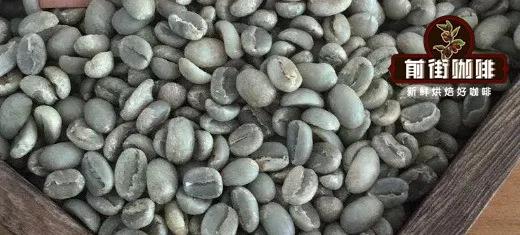
[Ethiopian Coffee Bean treatment]
In the memory of many people, Ethiopia has always been a producing area dominated by water washing treatment. Qianjie believes that Ethiopia likes to use water washing treatment so much because it can highlight the fragrance of flowers and the acidity of lemons in Ethiopia. Bring a little freshness to everyone. In fact, the earliest method adopted in Ethiopia is the sun treatment. Since 1972, when the Ethiopian government introduced the washing method from Central and South America to improve the quality of coffee, it has made the coffee in Ethiopia more fresh and refined and won the favor of more people. Qianjie coffee thinks that Qianjie coffee has obvious acidity, good cleanliness, moderate touch and the most consistent quality of raw beans, while sun-cured coffee has lower acidity, higher sweetness and clearer touch than water-washed coffee, but slightly lower cleanliness. Flavor will produce more berry tonality, but also more complex.
[Ethiopian coffee bean grading]
The definition of the grade of Essex coffee is complicated. At first, the Ethiopian Ministry of Agriculture had a department called Cupping and Liquoring Unit (CLU for short), which was responsible for the quality approval of coffee for export. for washed coffee, the export grade was G1 and G2; for sun-tanned coffee, the export level was G3, G4, G4, G5, which means the highest level of sun exposure was G3. The Ethiopian Commodity Exchange Ethiopian Commodity Exchange (ECX), which was established in 2012, redefined the classification, with no change in the classification of washing, while the definition of sunlight appeared for the first time G1, which is why there is now a market where Ethiopian sunburn is G1 and G2, while G3 begins to change slowly. Front Street Coffee Ethiopian Coffee beans are all G1 grade.
[Ethiopian producing areas]
There are a total of nine coffee producing areas in Ethiopia: Sidamo, Yeru Sheffihara, Forest, Irubabo, Kinby, Tibby, Bebeca and Jinma. Among them, Yega Xuefei, Sidamo, Lim and Hara belong to Ethiopian boutique coffee producing areas. Yega Xuefei and Sidamo are even more famous.
Yirga cheffe is a small town in Ethiopia with an elevation of 1700-2100 meters. It is one of the highest coffee producing areas in the world and is synonymous with Ethiopian boutique coffee. The Rift Valley, represented by Misty valley, is foggy all the year round, like spring all the year round, with a gentle breeze, cool and humid, and thousands of coffee trees thrive, giving birth to the unique and unpredictable flavor of Yega Xuefei, which is intertwined with flower and fruit aromas. The former street sensation believes that the so-called Yega Chuefei flavor refers to the rich citrus lemon fruit acid, rich jasmine aroma, light and elegant taste, with a sense of tea, and tastes like fresh and clean lemon tea.
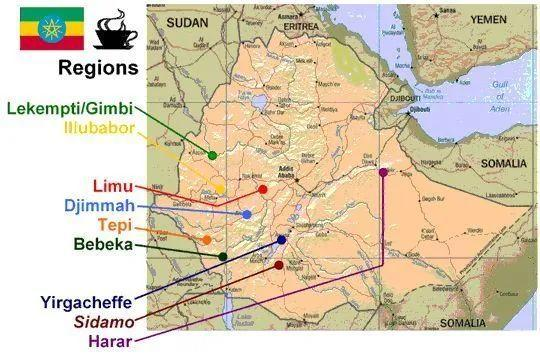
Sidamo (Hidamo) is a province of Ethiopia and the superior administrative unit of the famous Yegashafi. Sidamo is the southernmost coffee producing area in Ethiopia, with an average elevation of 1400-2000 meters above sea level. The coffee produced is obviously sweet, known as sweet coffee. Qianjie believes that sunny Sidamo has a light floral aroma, rich berry acidity and a sense of fermentation, which is smoother than that of washed Sidamo.

Front Street Coffee-Yega Xuefei Fruit Tintin Cooperative Coffee beans
Producing area: Yega Xuefei Gedeo Zone producing area
Altitude: 1900-2300m
Variety: original species (Heirloom)
Treatment: insolation
Grade: G1
Cooking flavor: the overall taste is solid, fermented and tropical fruits are more prominent, with the change of temperature, showing the flavor of berries and cream, the aftertaste of citrus between the teeth and lips is more long-lasting.
Qianjie Coffee roasted Fruit Ding Ding Coffee beans suggestion
The furnace temperature is 175 ℃ into the pot, the throttle opens 3, the firepower is 120; the temperature recovery point 1 temperature is 39 ℃, the firepower remains unchanged, the throttle opens to 4; at this time the bean surface turns yellow, the smell of grass disappears completely, and enters the dehydration stage, when the firepower drops to 100176 ℃ at 166℃, the firepower drops to 80, and the throttle remains unchanged. The smell of toast obviously changes to the smell of coffee, which can be defined as a prelude to an explosion. At this time, it is necessary to listen carefully to the sound of the explosion point. When the sound of the explosion starts, adjust the throttle to 5 (the tuning power should be very careful, not so small as to be so small that there is no burst sound). After an explosion, the development of 1 cup 39th 30 ", 193.5 ℃ into the pot.
2. Kenya (flavor features: strong acidity, outstanding raspberry virgin fruit)
As we all know, coffee originated in Ethiopia in Africa and was discovered as early as the 9th century. However, neighboring Kenya did not introduce coffee until near the 20th century, during which coffee went around the world almost all the way back to Africa. And at that time, the coffee industry began to have new changes, and Kenya can be said to be the witness and promoter of this change.
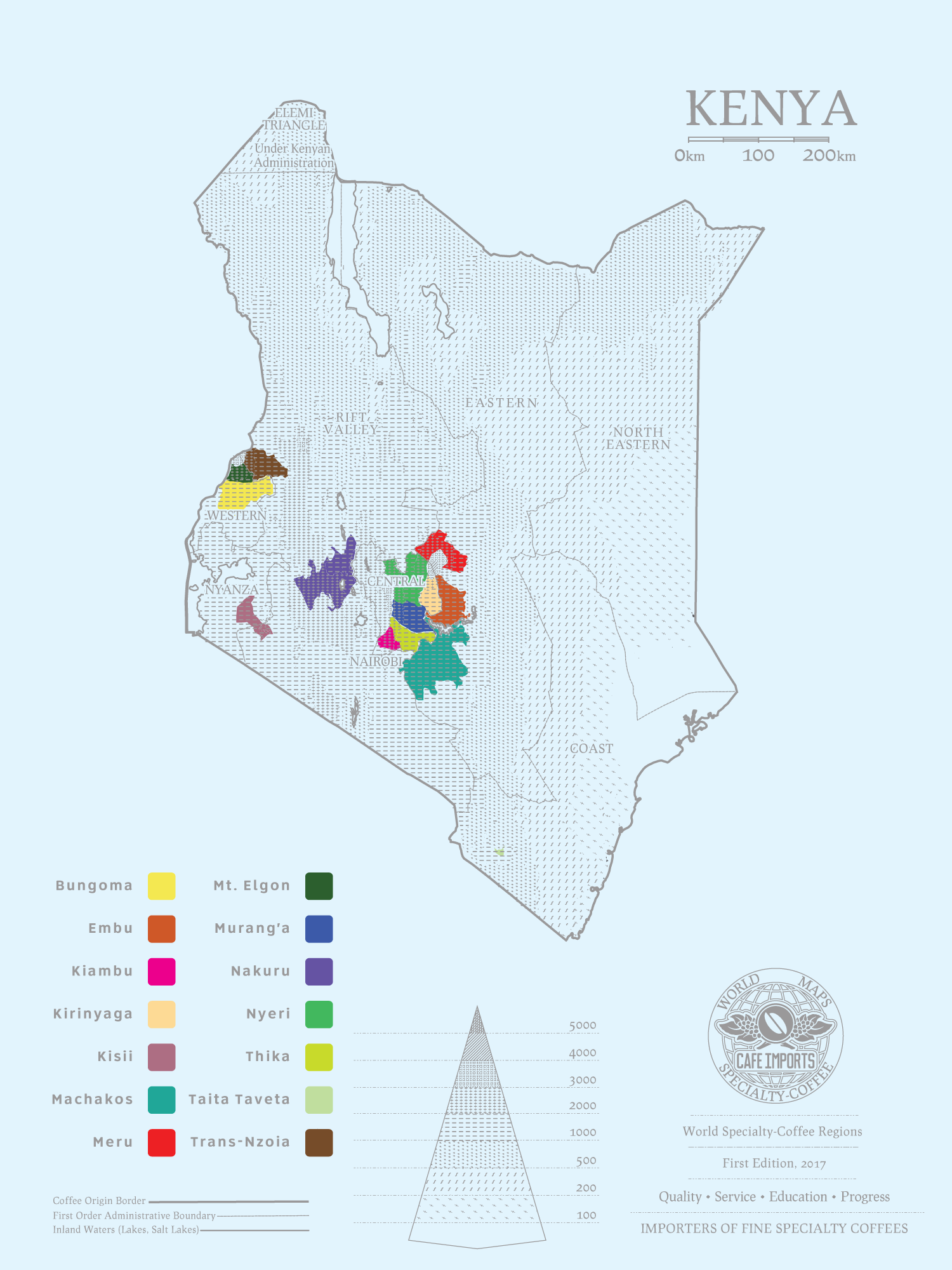
[Kenyan coffee beans]
Lmur28 and SL-34. This is the second of 40 varieties led by Guy Gibson of Scott Scott Laboratories Lab, which was cultivated and named in the laboratory in 1930. According to botanists in SL laboratory, SL28 and SL34 are genetic variants. They account for the vast majority of Kenya's high-quality coffee production, but these varieties are susceptible to leaf rust. SL34 has French missionaries, bourbon, and more Tibica ancestry. Copper leaf color and broad bean-shaped beans, Qianjie Coffee has passed the cup test, and Kenya beans have a great sense of sweetness, balance and complex flavor, as well as remarkable citrus and black plum characteristics.

[Kenya Coffee Bean grading]
Kenya is graded according to the particle size and cup test results of coffee beans. According to the size, shape and hardness of coffee beans, from high to low is AA or AA+, AB, PB, C, E, TT, T. For the raw coffee beans of AA grade and AB grade, the special classification of cup test results (not officially recognized by Kenyan countries, made by exporters) is added, and the order from high to low is TOP, PLUS (+) and FAQ.
[Kenyan coffee bean treatment]
Kenya adopts the cycle repeated treatment method of washing after fermentation, which is made after the same day of harvest. The best quality coffee berries are selected for peeling and fermentation. The fermentation time is 24 hours, and clean river water is used after 24 hours. Then, it is fermented again with clean river water for 24 hours, then washed, and repeated 3 times to reach 72 hours, so it is called Kenyan 72-hour fermentation water washing treatment, referred to as [K72]. Qianjie believes that coffee beans treated with 72-hour fermentation water in Kenya are fermented for a long time at low temperatures and finally dried and dehydrated, giving the beans a brighter, cleaner and fuller flavor.
[Kenya producing areas]
Kenya has the following six major producing areas:
① Xinanbu and Miao Langqi: most people like the bright acid and thick touch here, coupled with the fact that it is not far from Nairobi, there will be many foreign buyers to visit here during the production season.
② Nielli: bright blackberries and thick grease, coupled with citrus and even floral aromas, the boutique beans here are also a major contributor to Kenya's international reputation.
③ Qilin: the flavor here is also bright sour, with a moderate greasy feeling and delicate sweetness.
④ Anbu area: it is not as strong as Nieli, with a balanced and clear flavor and a good finish.
⑤ Marchaikos District: this area has a rising trend, clear fruit acid and meticulous flavor, moderate touch and delicate and fresh tail rhyme is very famous, attracting many buyers in recent years.
The western producing area of ⑥: its flavor is very different from that of the central producing areas, attracting buyers with medium-thick sweetness and milder flavor. Some of the washing fields in this area rely on hazelnut and mild fruit style, and are also widely ignored by buyers who do not like bright acidity.

Front Street Coffee-Kenya Asalia Coffee Bean
Production area: Thika, Kenya
Treatment plant: Asali Honey Treatment Plant
Altitude: 1550-1750 m
Rating: AA TOP
Varieties: SL28, SL34
Treatment: Kenya 72 hour wash
Brewing Flavor: Black plum and cherry flavors on the palate, strong acidity, thick taste, sweet middle, juicy, fruity and sweet yellow sugar aftertaste, and green tea aroma.
How does Front Street Coffee roast Kenyan coffee beans?
Preheat the furnace temperature to 200 ℃, enter the boiler, open the damper for 3, 30s, open the fire, adjust the fire to 160, keep the damper unchanged, return to the temperature point of 1 34", maintain the fire, turn yellow at 5 30", the smell of grass disappears, enter the dehydration stage, reduce the fire to 130, reduce the fire to enter the Mena reaction, reduce the fire again to 178 ℃, lengthen the Mena reaction time, and open the damper to 3.5. 7 45"dehydration completed, fire to 80, 8 30" is the bean surface wrinkled and black stripes, toast flavor to coffee incense, a prelude to explosion, then pay attention to listen to the sound of an explosion. At 8 52"start 1 burst, throttle open 5, fire down to 50, reduce caramelization. When the first burst begins, the heat absorption is strong, so it is recommended to maintain heat at this stage to prevent stagnation. A burst takes longer to develop, helps reduce acidity and develops flavor. The development time after explosion is 2 minutes and 10 seconds, and it is put into the pot at 191.6 degrees.
Latin American coffee-producing countries
Latin America refers to the region of the Americas south of the United States, that is, the continent located between 32°42′ north latitude and 56°54′ south latitude, including Mexico (North America), Central America, West Indies and South America. Coffee in Latin America originated in the eighteenth century and was inseparable from Spanish colonial rule at that time. Spanish was also the common language of most countries in Latin America. Brazil mainly used Portugal (formerly Portugal colonial rule). Fertile volcanic soils, wet weather and high altitudes of Latin America are ideal for coffee cultivation. Latin American coffee is generally washed and fermented. The rigorous processing ensures that the coffee beans produced are of good quality, low defect rate, and large and complete beans. Latin American coffee beans are known for their balanced overall flavor, usually with cocoa, dark chocolate-like full-bodied flavor. Representing coffee producing countries Brazil, Colombia, Panama and Costa Rica.
1. Brazil (flavor characteristics: low sour taste, heavy nutty taste, good body)
Brazil is the world's largest coffee producer and second largest coffee consumer (after the United States). Although Brazil faces several times more natural disasters than other regions, it has enough arable land to make up for them. Brazil has been delayed in picking coffee this year in 2020 due to the impact of the new crown epidemic, but analysts say exports are expected to hit a record this year. (This information comes from the coffee financial network report)

[Brazilian coffee bean treatment]
Before 1990, almost all of Brazil adopted rough sun treatment, which made Brazilian beans easy to catch the smell of rotten wood or soil, because coffee fruits go through a two-to three-week exposure process, and when it rains and returns to tide, it is easy to produce mildew. In order to change this situation, Brazil strictly rejected Brazil's relatively dry climate in 1990 and developed half-sun tanning (Pulped Natural) to shorten the processing time. In the process of removing the peel and pulp of coffee in the sun treatment, the ripe pulp will be removed easily, and the immature green fruit peel is not easy to deal with, so the second screening can be carried out to filter the immature fruit and unify the maturity of the coffee fruit. Compared with the sun drying method, Qianjie believes that the cleanliness and maturity of the coffee beans will be improved, resulting in a more uniform taste of coffee. The introduction of half-sun treatment does not mean that it is used in all Brazilian producing areas. Shirado with low incense humidity is mainly used in the sun treatment, while half-sun hair is a supporting role in Hiladow, but the red bourbon in the front street coffee area is treated by half-sun treatment.
[Brazilian producing areas]
Brazil has 21 states and 17 states produce coffee, but seven of them produce the most, accounting for 98% of the country's total output. They are:
State of Sao Paulo (Mogiana, Centro-Oeste)
State of Parana (Norte Pionerio do Paran á)
Bahia State (Planaltoda Bahia, Cerrado da Bahia, Atlantico Baiano)
Espiritu Santo (Montanhas do Esp í rito Santo, Conilon Capixaba)
Minas Gerais State (Sul de Minas, Cerrado Mineiro, Chapada de Minas, Matas de Minas)
Londonia (Rondnia)
Rio de Janeiro State (Rio de Janeiro)
[Brazilian coffee bean grade]
① is graded according to defect rate: there are seven levels of No2- No8 from high to low, and the number of defective beans per 300g is graded. The deduction system is used, and the deduction below 4 can be classified as No2 (No1 without a defective bean is rare and can not maintain a certain supply).
② was graded according to the size of Leguminosae: the highest grade was 17 mesh and 18 mesh.
③ cup quality classification: from high to low, Fine Cup, Fine, Good Cup, Fair Cup, Poor Cup, Bad Cup. FC (Fine Cup) and GC (Good Cup) are more common.
④ flavor grade: from high to low, Strictly Soft is very supple, Soft is very supple, Softish is a little supple, Hardish is not palatable, Rioy iodine choking taste.
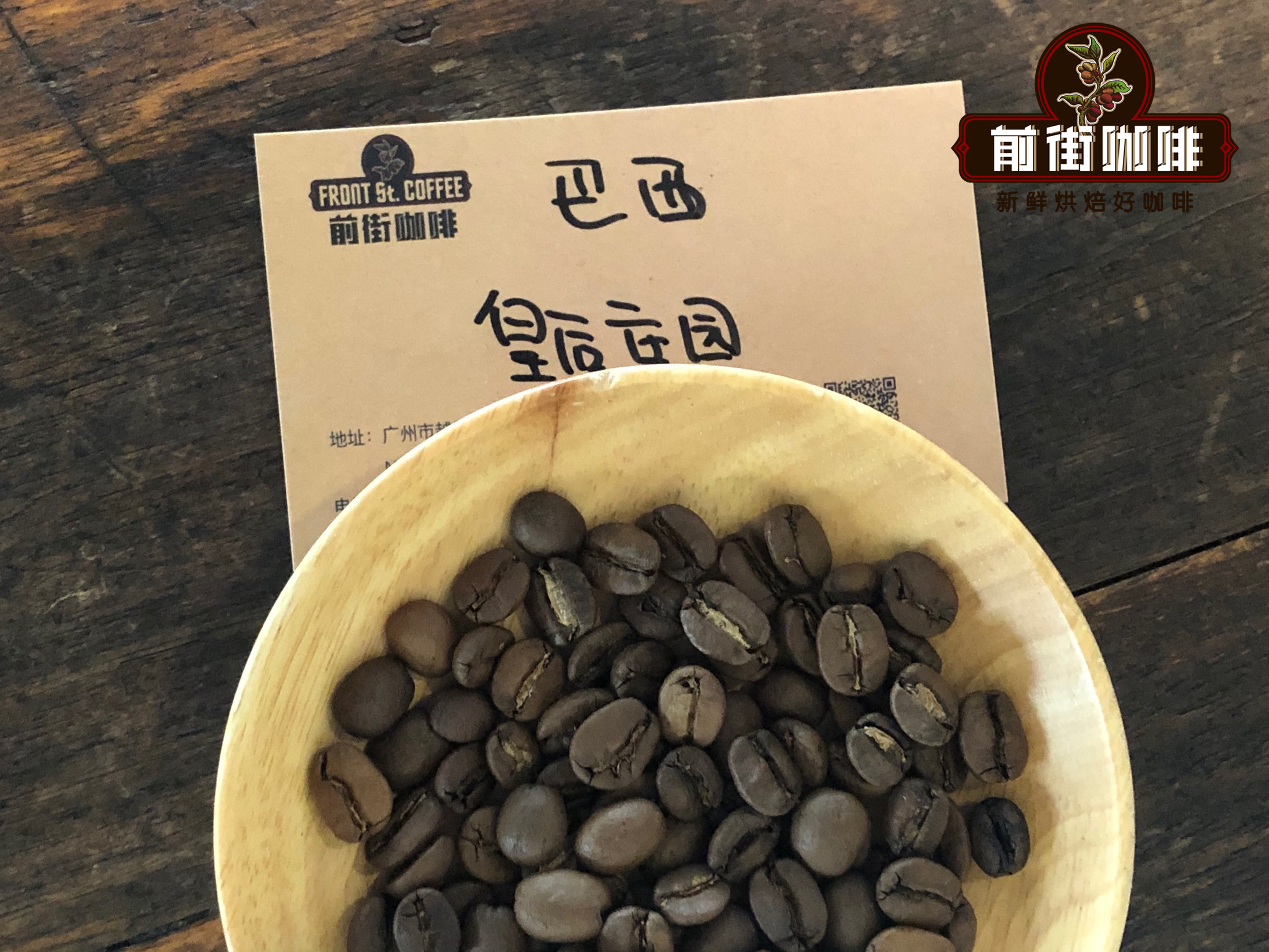
Front Street Coffee Brazil-Queen's Manor Coffee beans
Producing area: Morgiana
Altitude: 1400Muth1950m
Variety: yellow bourbon
Treatment: sun treatment
Cooking flavor: sweet beans, clean, half-sun use will make her slightly bright acidity but also good with the sweet knot, some even have tropical fruit aromas.
Qianjie Coffee Roast Queen Manor Coffee beans suggestion
Warm up to 200 degrees in the facility and enter the pot, firepower adjustment 150, throttle opening 3, temperature recovery point 1 / 39 / 30, maintain firepower, 5 / 15 / 39 / 10 turns yellow, grass smell disappears, enter the dehydration stage, firepower is reduced to 125, throttle is opened to 3.5. After dehydration, the bean surface appeared wrinkles and black markings, and the taste of toast changed to coffee, which was a prelude to an explosion. When the firepower dropped to 80 at 178 degrees Celsius, you should pay attention to the sound of an explosion. When 9 degrees 39, 14 "began to explode, the throttle door was fully open. After an explosion, the development time is 390 degrees 3900 minutes. 201 degrees.
2. Colombia (flavor features: sour and raspberry aroma, and caramel aroma, full of sweetness)
Colombia is the world's third largest coffee producer, located in the tropics, and the climate varies according to the topography. The southern part of the eastern plain and the Pacific coast have a tropical rain forest climate, the mountains with an elevation of 1000-2000 meters have a subtropical climate, and the northwest has a savanna climate. Rich landforms, low latitudes, high elevations and diverse microclimates give Colombia a place in the field of boutique coffee. Qianjie coffee through the cup test that Colombian coffee has a full taste, heavy texture. It has nutty, chocolate, caramel and other aromas and supple pleasant acidity.
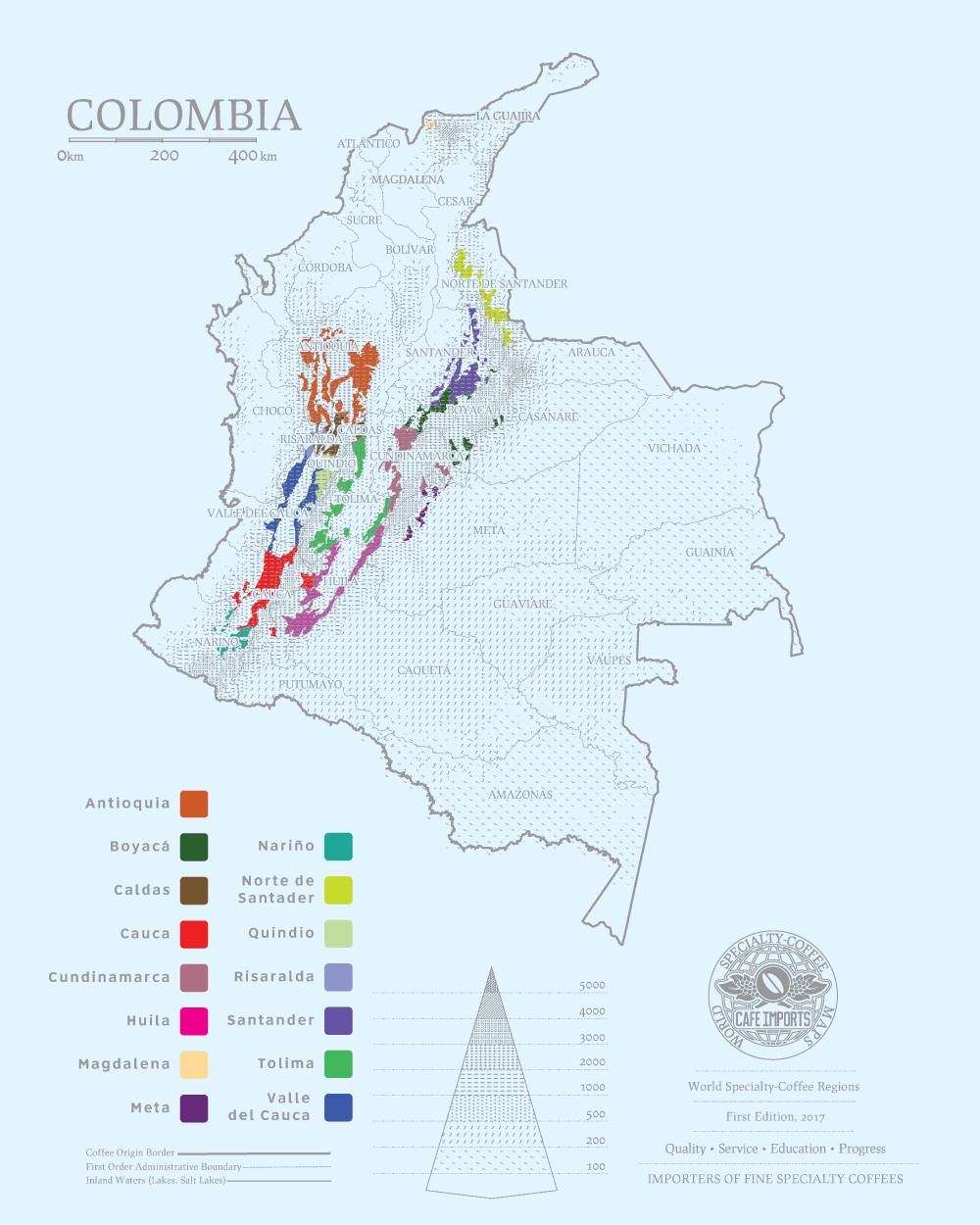
[Colombian coffee bean treatment]
Colombian coffee beans are mainly treated with water. With the prevalence of special treatment and the "no refusal" of Colombian coffee beans, more and more special treatments are applied to Colombian coffee beans. Water washing treatment is that coffee farmers first pour the picked coffee berries into a large tank, the immature inferior beans will float to the surface, and the ripe and full fruits will sink to the bottom. At this time, the defective fruit floating on the surface will be removed. Then use the pulp sieving machine to remove the outer skin and pulp of the coffee fruit, when the coffee beans are still attached to a layer of slippery pectin.
Put the coffee beans with pectin in the fermentation tank for 16 hours and 36 hours, during which the microbes will decompose the pectin. After the fermentation is completed, a large amount of water is used to remove the pectin residue from the coffee beans. Finally, the washed coffee beans are dried in the sun.
[Colombian producing area]
Colombian coffee production area is divided into two parts, one is located in central Colombia, the main producer of coffee beans, low altitude, about 1000m. The region known as MAM,M refers to Medlillin, the capital of Antioquia, A refers to Armenia, the holy capital of Kindio, and an M refers to Manizales, the capital of Calda province. The coffee beans produced in the middle of the central region are low-sour, mellow and sweet, a bit close to the flavor of Indonesia's Mantenin. Part of it is in south-central Colombia, where the best coffee beans of the year for all previous SCAA years come from. Here is full of volcanoes, is a Crouching Tiger Hidden Dragon boutique coffee bean producing area. The region includes the provinces of Tolima (Tolima), Cauca (Cauca), Huilan (Huila) and Nalinglong (Naeino).

Front Street Coffee-Columbia Huilan Coffee beans
Country: Colombia
Producing area: Huilan
Altitude: 1500-1800 m
Variety: Kaddura
Treatment: washing treatment
Cooking flavor: nuts, dark chocolate, caramel, soft fruit acid.
Qianjie Coffee roasted Huilan Coffee beans
Yangjia 800N, bean dosage: 480g. Furnace temperature to 180℃ into the pot, throttle open 3, firepower is 130C; furnace temperature to 140C, throttle open 4; furnace temperature to facility 150.6 °C, turn yellow point 6pm 39t20 ", when the bean table turns yellow, the smell of grass disappears completely, enter the dehydration stage, when 180℃, the firepower drops to 100and the throttle remains unchanged. The smell of toasted bread has obviously changed to the smell of coffee, which can be defined as a prelude to an explosion. At this time, it is necessary to listen carefully to the sound of the explosion point. At this time, the sound of the explosion point will start to explode. The throttle will be fully opened. After the explosion, there will be a development of 1mm bread 39th 50 ", and 196 ℃ will be put into the pot.
3. Panama (flavor characteristics: bright sour taste represented by Rosa rugosa)
Panamanian caffeine is famous all over the world, which is closely related to Panama's unique physical and geographical conditions and fine management model. After Panama opened the canal at the end of the 20th century, many American elites went south, on the one hand, to demand jobs, and on the other hand, to tap business opportunities. At this time, coffee developed by leaps and bounds, which established Panama's position in boutique coffee. In 2004, Panama's Rose Summer Coffee first smelled fragrant, and Lien Chan's good performance made the world known as the "birthplace of the finest Rose Summer Coffee in the World" and became the new overlord of boutique coffee industry. Through the cup test in Qianjie, it is found that Rosa coffee has rich floral aroma, citrus acidity, and nectar-like sweetness.

[Panamanian coffee bean treatment]
When it comes to Panamanian coffee beans, most of them are rose summer varieties. In the treatment of rose summer coffee beans, it is common to use water washing and sun treatment, which can reflect the original fragrance and sour flavor of rose summer flowers, and the sun rule adds a sense of richness and sweetness on the basis.
[Panamanian producing area]
There are four main coffee producing areas in Panama: Poquet Boquete, Walken Volcan, Santa Clara Santa Clara, Kendra Piedra de Candela. Pokuit production area has our familiar Emerald Manor, Arida Manor, Catova Manor and so on.

Qianjie Coffee--Emerald Manor washed green coffee beans
Region: Panama Poquet
Manor: Emerald Manor
Altitude: 1600 - 1800 m
Breed: summer rose
Treatment method: washing treatment
Brewing Flavor: Jasmine flowers, sweet, citrus, berry, juice, cream, green tea, orange peel, Hami melon, overall rich flavor layers, lingering fragrance, citrus.
Front Street Coffee Roast Green Label Rose Summer Coffee Bean Suggestion
The oven temperature is 190 ℃, the fire power is 150, the damper is opened 3; the temperature returning point is 136 ", when the oven temperature is 140 ℃, the damper is opened to 4, and the fire power is reduced to 130; when the oven temperature is 150.8 ℃, the bean surface turns yellow, and the grass smell completely disappears, entering the dehydration stage; when the oven temperature reaches 166 ℃, the fire power is adjusted to 110; the damper is unchanged; when the oven temperature is 755", the fire power is adjusted to 90 at 176 ℃; the ugly beard wrinkles and black stripes appear on the bean surface, and the taste of toast obviously changes to coffee fragrance, which can be defined as the prelude of the first explosion. At this time, the sound of the first explosion point should be heard clearly. The first explosion starts at 8 30", the damper is opened to 5, and the fire power is adjusted to 60 at 187 ℃; after the first explosion, the bean surface develops to 130, and the oven is placed at 193.5 ℃''''
4. Costa Rica (flavor characteristics: chocolate aroma and nutty flavor, moderate sour and sweet feeling, mellow)
Costa Rica was the first country in Central America to grow coffee and commercialize it. After Costa Rica got rid of Spanish colonial rule, the local government began to support the coffee industry with a series of policies, which promoted the development of private estates. Qianjie Coffee found that the coffee tasted quite mild and supple through cup test, with sour, sweet and bitter aromas of chocolate nuts, and the overall flavor was very balanced.

[Costa Rican coffee bean treatment]
. Costa Rican coffee beans mostly use the local original honey treatment method to treat coffee beans. Qianjie believes that honey-treated coffee has a balance between sour taste and sweet taste, and because of the sun exposure, the aroma of coffee beans themselves will be magnified and mellow. With the maturity of the technology of honey treatment, people have created the method of treating raisin honey through the improvement of honey treatment, which increases the difficulty of honey processing method. but the fermentation feeling and aroma of the coffee beans are more intense and make the coffee flavor have the taste of white wine and balanced sour taste.
[Costa Rica producing area]
Costa Rica mainly has eight major coffee producing areas: West Valley in the western valley, Central Valley in the central valley, Tarrazu in Tarasu, Tres Rios in the Sanshui River, Orosi in Europe, Brunca in Brenka, Duli Alba Turrialba and Guanacaste in Guanacaster. Among them, the Central Valley, Tarazhu and Sanhe producing areas are the most famous.

Front Street Coffee-Costa Rican Carnett musicians Series Bach Coffee beans
Country: Costa Rica
Producing area: Tarazhu
Altitude: 1950m
Treatment: raisin honey treatment
Grade: very hard bean SHB
Variety: Kaddura
Brewing flavor: it smells like the fermented aroma of rice wine, with sweet and sour taste of ripe tropical fruits and berries, nutty and creamy flavor, caramel and a hint of flowers on the finish.
Qianjie Coffee roasted Bach Coffee beans suggestion
The furnace temperature is preheated to 180 ℃ to enter the pot, the firepower is adjusted to 130, the throttle opens to 3, and the temperature return point is 1 / 3 / 39 / 43 "to keep the firepower; at 140 ℃, the firepower remains the same, the throttle is opened to 4. 6 ℃ / 39 / 15" turns yellow, the smell of grass disappears, entering the dehydration stage, the firepower is lowered to 100 at 151 ℃ and the throttle remains 4. Adjust the firepower to 70 at 176℃, the throttle will not change. After dehydration, the bean surface appears wrinkles and black markings, and the smell of toast changes to coffee, which is a prelude to an explosion. Listen to the sound of an explosion. When the sound of the explosion begins, the throttle is fully open for 5, and the firepower remains the same. After an explosion, the development time is 1mm, 39th, 45th, to 196℃, put into the pot.
Coffee beans from Asian regions
The output of coffee beans in Asia is second only to Latin America, among which Vietnam is the first coffee producer in Asia. Through the cup test in Qianjie, it is considered that the thickness of Asian coffee is higher than that of Latin America and Africa, but the acidity is less elegant, with wood, herb and spice flavor, and the low muggy flavor is higher than the rising fruit sour flavor. The coffee-producing countries are Indonesia and Yunnan, China.
1. Indonesia (flavor characteristics: good mellowness, herb incense)
Indonesia is located in southeastern Asia, and its coffee history dates back to 1696. Coffee farmers in the Netherlands tried to find a wider place to grow coffee and finally identified the Indonesian island of Java. After 30 years, Indonesia has laid a sufficient foundation in the coffee market. Today, however, Indonesia's coffee is represented by Mantenin, which is not unexpected, because most of the Javanese coffee sold to Europe came from Sumatra, and Mantenin came from Sumatra. So Sumatra can be said to be an important coffee producer in Indonesia.

[Indonesian Coffee Bean treatment]
Mantning mostly uses Sumatra's unique coffee bean treatment, the wet planing method. As the local weather is often dominated by Rain Water, with continuous typhoons, it is unable to achieve the good weather needed for the sun, and the local economy is not good, so it is also impossible to use the more expensive way of washing, thus giving rise to the wet planing method with local characteristics. In the first stage, the peel and pulp were removed by a wooden peeling machine, and after fermentation for 3 hours, the moisture content was reduced to 30-50% of semi-dry and semi-wet. In the second stage, the pectin and sheep skin were removed and the latter part of the drying process took 2-4 days, and the moisture content was reduced to 12-13%.
In addition to the conventional wet planing, there is also an old wet planing method. Coffee beans are first treated by ordinary wet planing, and then sealed in the warehouse for 2 to 3 years. The environment of the warehouse must be cool and ventilated, and the beans should be turned regularly to prevent mildew and corruption. During this period, the acidity of coffee beans will slowly weaken to sugar, and the color will become darker, mostly yellowish brown or dark brown. The mantenin coffee beans that use this treatment are also called old mantenin coffee beans.
[Sumatra, Indonesia]
The famous coffee producing areas in Sumatra are the GAYO Mountains of Mount Geo (that is, Aceh), Lintong (Lindong) and Sidikalang (West Calang). The common mantenin comes from the Lindong producing area, which can best represent the flavor of conventional mantenin. The high-grade mantenin, which is often mentioned on the market, is also known as Golden Manning, which comes from the producing area of Lake Tawa (the micro-producing area of Mount Geo).

Qianjie Coffee-Golden Manning Coffee beans
Producing area: Aceh Jiayu Mountain in Sumatra
Altitude: 1100-1600 m
Variety: Ateng
Grade: G1, 3 times hand selection
Treatment method: wet planing method
Cooking flavor: herbs, spices, mellow and clean, high sense of balance, strong nutty and caramel aromas, with chocolate aromas and a long finish.
Qianjie Coffee Baking Gold Manning Coffee Bean suggestion
Put the furnace temperature to 200 degrees Celsius, adjust the firepower to 160 degrees after opening the throttle for 1 minute, keep the throttle unchanged, bake to 5: 40 ", the temperature is 148 degrees, the bean surface turns yellow, the smell of grass disappears completely, the dehydration is completed, the firepower is adjusted to 140 degrees, and the throttle is changed to 4. In the 9th '40th minute, ugly wrinkles and black markings appear on the bean surface, and the smell of toast obviously changes to the smell of coffee, which can be defined as a prelude to an explosion. At this time, listen carefully to the sound of the explosion point, start to explode at 9: 54 ", turn the firepower down to 60 degrees, and the throttle is fully open (adjust the firepower to be very careful, not so small as to be free of bursting sound), and put the pot at 204.5 degrees.
2. Yunnan, China (flavor characteristics: melon and fruit, nutty, tea, mellow)
Yunnan has the earliest history of growing coffee in China. In 1892 (18 years of Guang Xu of the Qing Dynasty), the French missionary Tian Deneng planted the first coffee tree in Zhugula Village, Binchuan, Dali, and opened the Chinese mainland street. Through cup testing of different Yunnan coffee beans in recent years, it is believed that it has the aroma of melon and fruit, the bright acidity of plums, the sweetness of brown sugar, the finish of nuts, sweet and obvious, rich aroma and mellow taste. The prelude to planting coffee. Lujiangba in Baoshan, dry and hot valley climate is very suitable for the cultivation of coffee, because the back of Gaoligong Mountain coffee garden can reach 1500 meters above sea level. In 1952, the first trial in Baoshan area was just half of China's 100-year history of coffee. In the early days, Arabica varieties were introduced in the village, mainly iron pickup and bourbon.
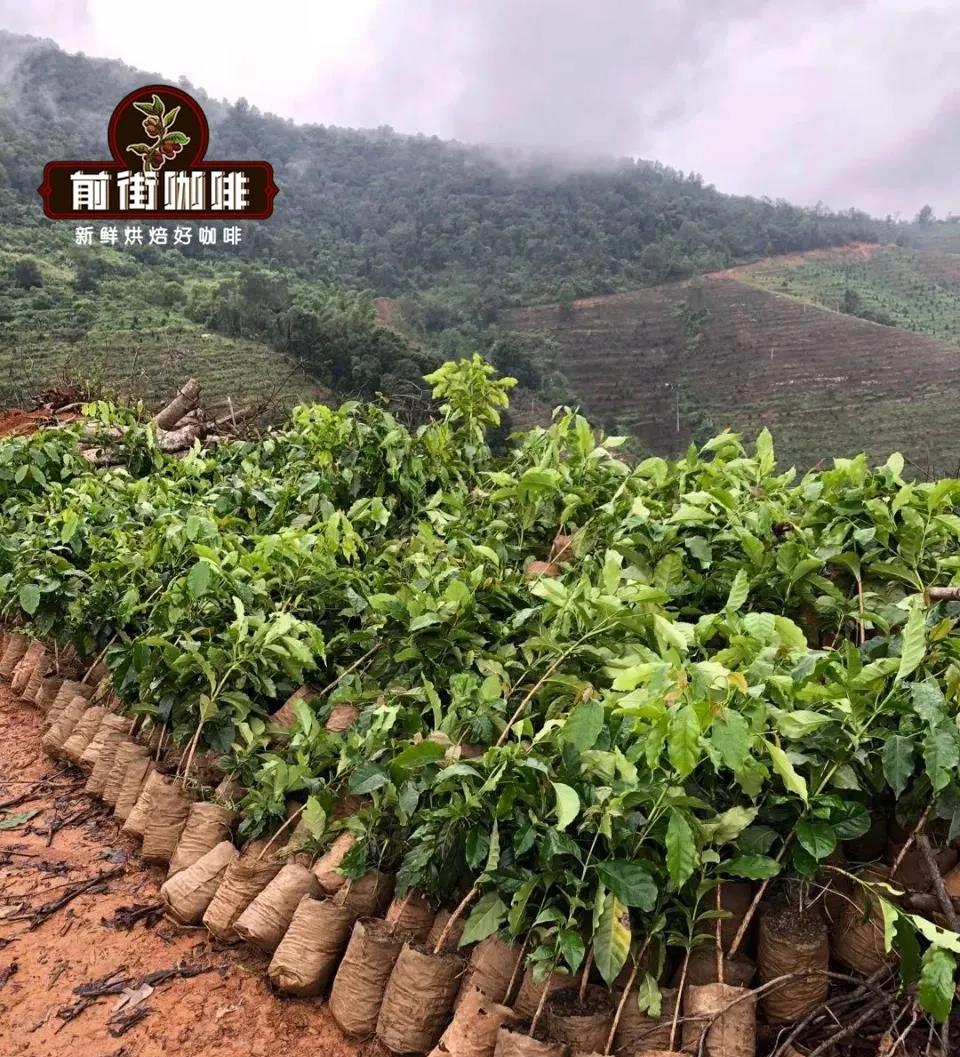
[Yunnan producing area, China]
Coffee cultivation in Yunnan is mainly distributed in Lincang, Baoshan, Pu'er and Dehong, where there are natural resources of low latitude, high altitude and large temperature difference between day and night, which makes Yunnan a golden growing area for producing Arabica coffee with high quality. The area of coffee bean planting in Yunnan was not divided well at the beginning, which led to the fuzziness in the classification and screening.
[Yunnan Coffee Bean treatment]
Qianjie came to the Yunnan producing area of the planting season and really realized what the rainy season is. It is sunny for a few minutes and it rains for half an hour. Because of the perennial rainy season and unstable climate, most coffee beans in Yunnan are treated with water washing. Use a peeling machine to separate most of the pulp from the coffee beans, then guide the shelled beans to a clean sink, soak them in water and ferment to completely remove the residual pulp layer. In the past (about five years ago), washing was often the first choice for good coffee bean treatment. Through water treatment, unripe beans and defective beans are selected because of buoyancy, and the fermentation process is easier to control, so the flavor is not mixed like sun beans, but shows obvious acidity, complexity and cleaner (without any negative flavor, such as astringency or sharpness).
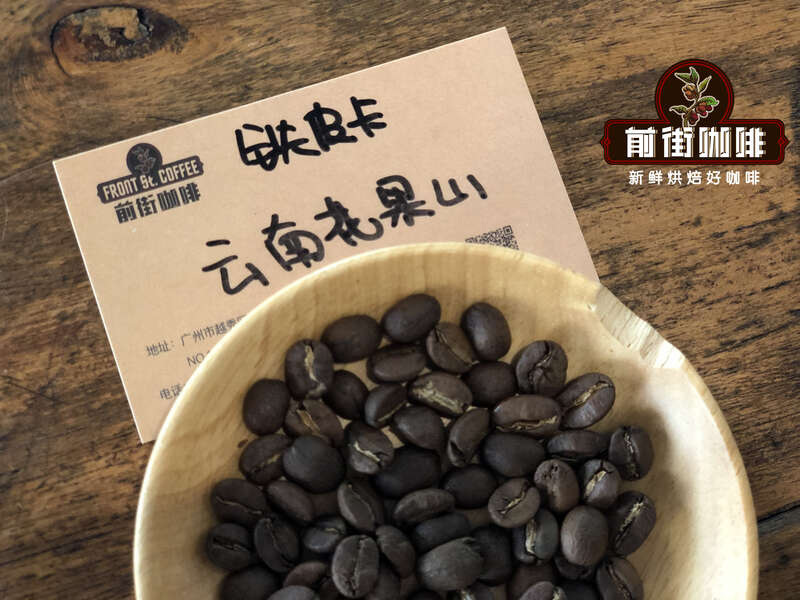
Qianjie Coffee-- Coffee beans in Yunnan, China
Coffee producing area: China, Yunnan, Baoshan
Variety of coffee: iron pickup Typica
Production altitude: 1200m
Quality level: AA
Treatment: washing
Qianjie Coffee Baking Yunnan Huaguoshan Coffee Bean suggestion?
Put the furnace temperature to 200 degrees Celsius, adjust the firepower to 160 degrees after opening the throttle for 1 minute, bake to 5 degrees Celsius 39 degrees Celsius for 32 seconds, bake to 5 degrees Celsius 39 degrees Celsius and turn yellow, the temperature is 149 degrees Celsius, the smell of grass disappears completely, dehydration is completed, the firepower remains unchanged, the throttle changes 4. In the 6th minute, the firepower was adjusted to 140, in the 7th minute, the firepower was adjusted to 120, and in the 8th minute, ugly wrinkles and black markings appeared on the bean table, and the smell of toast obviously changed to coffee, which could be defined as a prelude to an explosion. At this time, listen clearly to the sound of the explosion point. Start to explode at 8: 37 ", fire power is 90, the throttle is fully open, and the firepower is adjusted to 20 degrees in the 9th minute. Go to the pot.
For more boutique coffee beans, please add private Qianjie coffee on Wechat. WeChat account: kaixinguoguo0925
Important Notice :
前街咖啡 FrontStreet Coffee has moved to new addredd:
FrontStreet Coffee Address: 315,Donghua East Road,GuangZhou
Tel:020 38364473
- Prev

Starbucks Coffee Bean Mill Grade Degree Grade
Starbucks coffee bean grinding fine grinding grade degree grinding coffee powder and cooking time cut potato shred a reason potato shred too fine easy to paste too coarse and not easy to cook, so the same coffee powder ground too fine easy to extract too coarse and easy to extract insufficient specific grinding degree depending on the extraction method and coffee bean varieties Roasting and storage time, and everyone tastes different
- Next

The shelf life of cooked coffee beans-which is better, French pressing pot or siphon pot?
Shelf life of cooked coffee beans-which good coffee beans can not be boiled directly, French presser or siphon pot? coffee beans need to be ground into coffee powder in the process of making coffee, so that the efficacy of coffee beans can be fully released. Coffee contains nutrients, such as vitamin B, and coffee has higher levels of vitamin B after roasting. In addition, coffee also has
Related
- Guji coffee producing area of Guji, Ethiopia: Humbela, Shakiso, Wulaga
- What is the most expensive variety of Qiloso in BOP multi-variety group?
- How to store the coffee beans bought home?
- Why are Yemeni coffee beans so rare now?
- Ethiopian Sidamo all Red Fruit Sun Sun Santa Vini Coffee beans
- SOE is mostly sour? What does it mean? Is it a single bean? what's the difference between it and Italian blending?
- Is Italian coffee beans suitable for making hand-brewed coffee?
- How to choose coffee beans when making cold coffee? What kind of coffee beans are suitable for making cold coffee?
- Just entered the pit to make coffee, what kind of coffee beans should be chosen?
- Can only Japan buy real Blue Mountain Coffee? What are authentic Jamaican Blue Mountain coffee beans?

